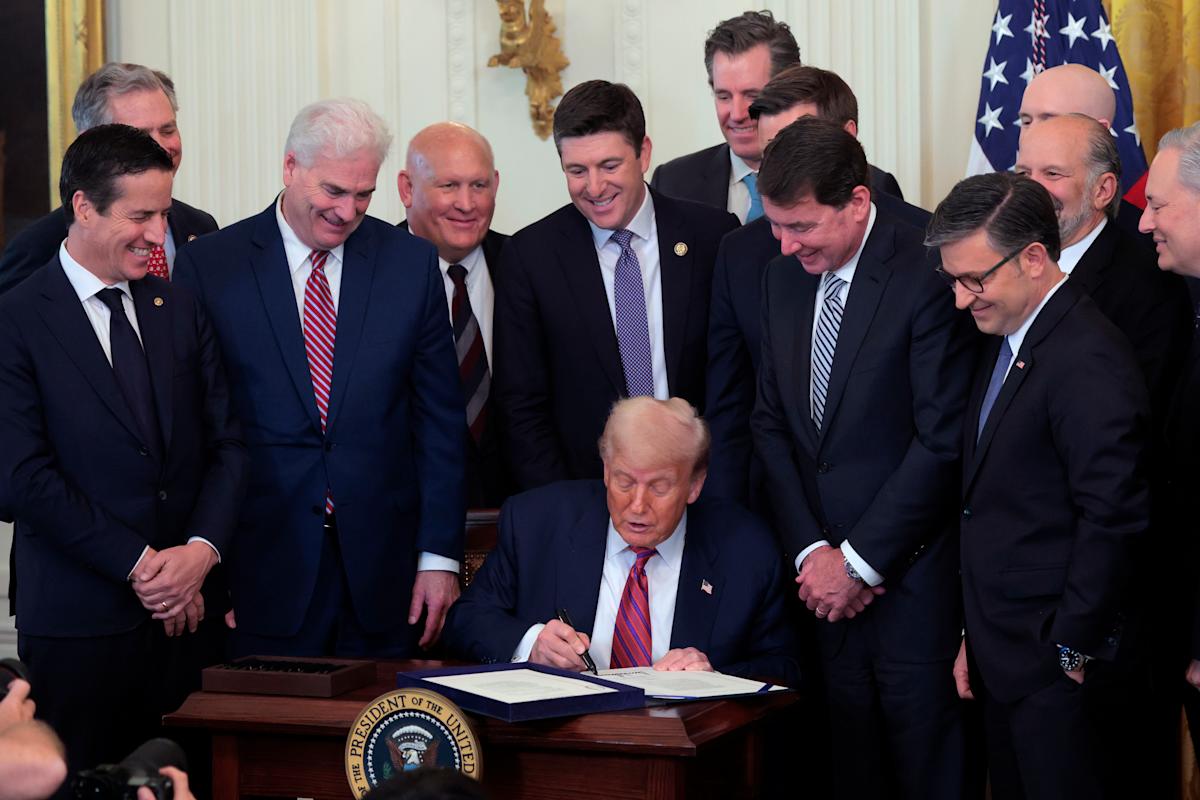WASHINGTON, DC – JULY 18: U.S. President Donald Trump, surrounded by lawmakers, signs the “GENIUS Act” into law during a ceremony in the East Room of the White House July 18, 2025 in Washington, DC. (Photo by Anna Moneymaker/Getty Images) · Anna Moneymaker via Getty Images
Canada risks falling behind the U.S. in developing digital payment systems based on stablecoins, raising concerns that the growing use of U.S. dollar–backed tokens could weaken the country’s monetary sovereignty, a new report from Desjardins warns.
“If Canada continues to fall behind, it will push Canadian users towards foreign-issued stablecoins,” said Mirza Shaheryar Baig, a foreign exchange strategist, in the report. “If this becomes widespread, it could increase pressure on the Canadian dollar and dilute the transmission of the Bank of Canada’s monetary policy.”
Shaheryar Baig says Ottawa should take Shopify’s recent decision to accept payments in the U.S. dollar–backed USDC token as a “wake-up call.”
Stablecoins are digital tokens designed to hold a steady value by linking to traditional currencies such as the U.S. dollar. Unlike cryptocurrencies like Bitcoin, whose prices swing with market demand, stablecoins aim to maintain a one-to-one peg with fiat money.
While advocates say they can make payment transactions faster and cheaper, the Desjardins report argues the digital asset doesn’t just represent a technological shift, but a geopolitical one.
“With most stablecoins pegged to the U.S. dollar, their global spread reinforces the greenback’s dominance,” Shaheryar Baig said. “The Trump administration is promoting USD-based stablecoins as a strategic tool to extend the dollar’s influence.”
Since the GENIUS Act requires stablecoins to be backed mainly by treasury bills, foreign adoption creates demand for U.S. debt, he adds. This is especially notable at a time when geopolitical rivals like China are reducing exposure to U.S. treasuries.
“For other countries, including Canada, if their citizens widely adopt USD stablecoins in payments, it could increase demand for U.S. dollars and erode their monetary sovereignty.”
In Canada, however, the use of stablecoins for everyday payments remains limited. While a handful of merchants and online platforms accept them, most businesses still rely on traditional payment systems, Shaheryar Baig says.
Still, several Canadian fintechs are making headway. Stablecorp and PayTrie have each launched Canadian dollar–backed stablecoins, known as QCAD and CADC. Tetra Trust, a regulated custodian, plans to launch its own CAD-backed stablecoin in early 2026 with backing from Wealthsimple, National Bank and Shopify, he adds.
Progress has been slow, largely because of regulatory uncertainty, Shaheryar Baig says.
In contrast, the U.S. and European Union have introduced clear rules through their GENIUS Act and Markets in Crypto-Assets framework, respectively. In Canada, oversight is split among federal regulators, provincial securities commissions and the Bank of Canada — a fragmented approach that Shaheryar Baig says has “hampered innovation.”
The Bank of Canada has called for a more unified national framework, warning that the current patchwork of rules creates confusion for both businesses and consumers. Advocates hope Ottawa will eventually introduce legislation similar to the U.S. GENIUS Act, setting standards for licensing, reserves, redemption rights and consumer protection.
Shaheryar Baig says once Canada establishes a coherent regulatory framework, stablecoin adoption will likely accelerate, following the same pattern seen in the U.S., where the GENIUS Act helped clarify the regulatory landscape and sparked industry growth.
While creating a strong CAD-backed stablecoin ecosystem is a meaningful goal, it doesn’t guarantee monetary sovereignty, he says. The Canadian dollar is a minor player globally, while the U.S. dollar leads blockchain-based payment systems.
“If USD-based ecosystems continue to deliver lower cost and better functionality, Canadian users may gravitate towards them, especially if homegrown alternatives don’t measure up.”

